Progression, Innovation and Caffeination: The Origins of the Coffeehouse

In our most recent editorial for Cafe Culture magazine, we explore the origins of the coffeehouse and follow its journey from humble beginnings as a social establishment housing artists and intellectuals to the global institution that we know it to be today.
The proliferation of the café in Australia throughout recent history has escalated to a point where it has become synonymous with the Australian way of life. Our “café culture” is world renowned.
Whilst we can wholly claim the culture we have built around our humble cafés, the origin of the coffeehouse is a tale of progression and innovation that began far from our shores.
Coffeehouses first appeared in Turkey, Syria and Egypt as early as 1530. They have long been associated with writers, artists and intellectuals. The coffeehouse represented a safe and comfortable space to share news, discuss politics and collaborate. The concept of the coffeehouse travelled with coffee as its popularity spread throughout Europe in the 17th century.
The coffeehouse played a crucial role in the birth of the age of enlightenment. Many innovations from this period have a coffeehouse in their story. They provided an alternate social space, in contrast to sacred places of worship and boozy alehouses, where creativity and innovation thrived. This surge in innovation was not only owing to the design of the space – the physical gathering together of people from different backgrounds and fields of expertise – but also to coffee itself. Where previously alcohol had been the beverage of choice for consumers, caffeine-rich coffee enabled a drastically different intellect. Switching from a depressant to a stimulant had obvious effects on productivity. Both physically and intellectually, it represented a shift towards progression and quickly became the fuel of change, inspiration and innovation.
Throughout the 1600s coffeehouses began popping up across Europe and North America, from London to Vienna and New York. These establishments were integral in the development of financial markets, newspapers, auctioneering and the insurance industry. The French and American Revolutions were said to have brewed in coffeehouses in Paris and Boston. Lloyd’s of London, a major insurance company, started out as a coffeehouse that was frequented by merchants and sailors. The quality of the coffee may not have been a priority at the time – it was said to be borderline undrinkable – but this proliferation was the beginning of the coffee drinking culture in Europe.
Throughout modern history, coffeehouses continued to function as a meeting place for writers and artists across Europe and often served as entertainment venues in the United States, hosting fledgling folk singers such as Bob Dylan during the American folk music revival.
In Australia, coffee was first popularised during World War II when American servicemen were stationed here. We were first introduced to instant coffee in 1947. It was promoted as a glamorous, quick, easy and cheap alternative to tea and proved popular in the home. This trend continued in the domestic market and soon garnered traction in the hospitality industry. Tea houses shut down and reopened as coffee shops. With the arrival of Italian migrants came the stove-top and espresso culture. European-style cafes and roasting businesses soon followed. As gentrification swept through the inner city suburbs in the early 1980s, cafés – some of which are still serving coffee today – began popping up on street corners of Melbourne and Sydney. Catering to the newly established latte-sipping clientele, this was the beginning of our caffeine obsession and world-renowned “café culture”.
Some may use the term “coffee snob”, but it is a generally accepted that Australians know a thing or two about coffee. Coffee and the identity of the “café” is firmly entrenched in our everyday culture. The number of cafes within a kilometre-block of the Melbourne CBD will attest to the significance we place upon getting our daily fix.
As a society, we classify coffee as a small yet significant luxury. The success of our “café culture” is not only in the quality of the beverage provided, but also the experience that our cafés deliver. The practice of ordering a morning coffee and interacting with café staff is a momentary distraction from the monotony of the daily grind. We show loyalty to our favourite café and will voluntarily walk an extra block to be greeted by a familiar face who remembers how we like our shot – provided they brew a good cup of coffee. For many, it is an intrinsic part of our daily lives.
Coffee is unique in that it is considered a luxury item yet it is inexpensive. It’s an affordable indulgence. Throughout the Global Financial Crisis, the coffee industry – speaking from a consuming country perspective – seemed to fare okay. Some consumers shifted from out-of-home to in-home consumption or moved from higher cost brands to cheaper alternatives but, on the whole, people continued to drink coffee. Coffee remained an affordable luxury, and one that was so deeply entrenched in our day-to-day lives that it was hard to shake.
The significance of the coffeehouse within modern society is perhaps not as integral as it once was, however the societal functions based around coffee continue to play an important role within many cultures around the world. The coffeehouse continues to be a place to socialise or work, share in cultural traditions, relish in being alone, or feel a sense of community amongst others. The coffee served in coffeehouses may differ depending on where you are in the world, but the establishment itself conveys a sense of familiarity and understanding that has the ability to transcend borders and linguistic barriers.
As an importer, the coffeehouse space is not part of our daily context. It is special when we do get the chance to visit one of our roaster’s cafés or café clients; to experience the culmination of the coffee supply chain. To appreciate the result of so many hands’ work.
Through our work we primarily facilitate the logistics of transferring coffee from origin to roaster. More importantly, we strive to share the story of the crop to cup process and to depict the interconnected nature of the industry. It is essential to pass this knowledge along the supply chain to educate the end consumer. Both for sake of the inquisitive consumer, who sidesteps the typical quest for caffeine and takes the time to question the origin or process of the coffee, and for the good of the grower and the longevity of the industry. It is important for us to contribute to the representation of a coffeehouse as a place of education and collaboration, and to ensure this depiction continues to ring true.
There is a common adage within the industry that correlates to the magnetism of the coffeehouse; once in coffee, always in coffee. Just as the nuances of a familiar café keeps you walking through the door, the coffee industry offers a myriad of knowledge and leaves you constantly striving to learn more. It is an industry, we believe, that is unparalleled. Its beauty lies in the connection it facilitates between so many different cultures and distant parts of the world. Each cup represents the culmination of a global community.
So next time you’re sitting in a café, enjoying a cup of coffee, take a moment to appreciate the historical significance of the establishment and contemplate its evolution, from humble beginnings housing artists and intellectuals to the globalised institution as we know it to be today.
For more on the history of coffee in Australia, we recommend starting with ‘A Good Brew: The History of H.A. Bennett & Sons and tea and coffee in Australia’ available for purchase from Bennetts, www.hab.com.au and selected bookshops.
First published in Cafe Culture Magazine, Issue 41 December 2015.


